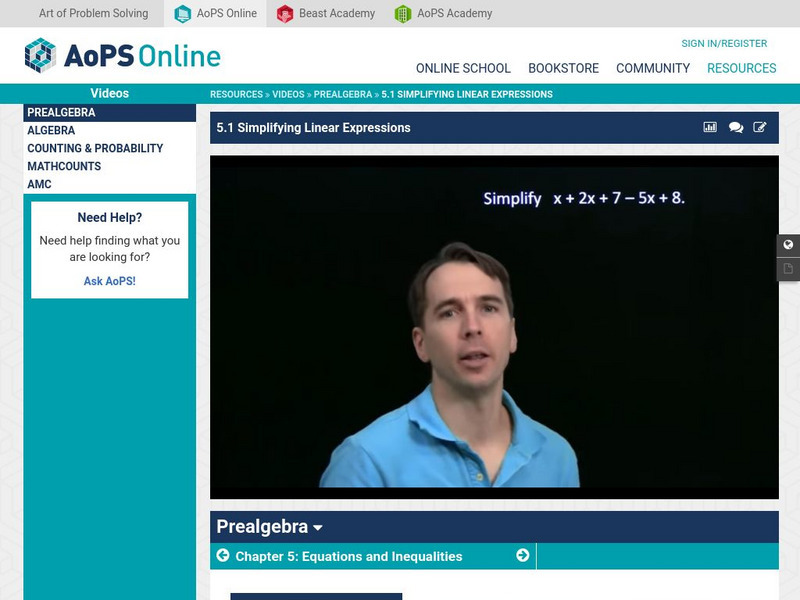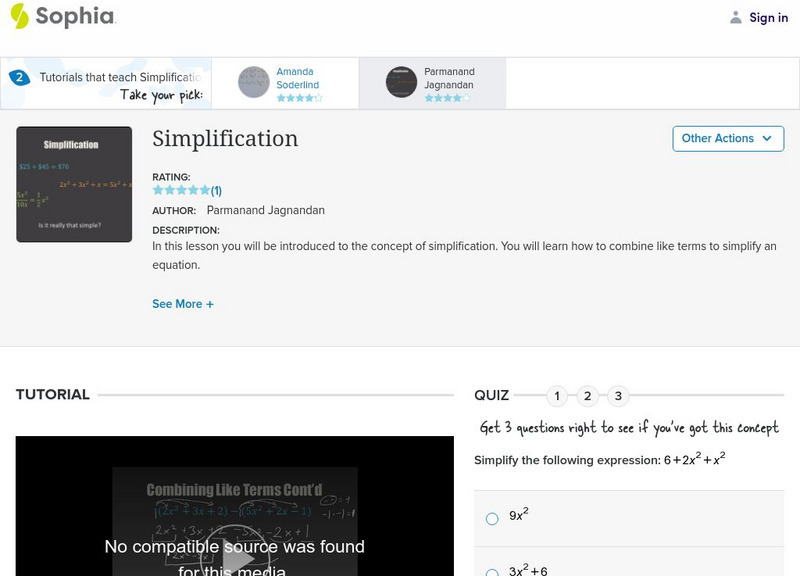Curated OER
How Do You Solve a Multi-Step Equation by Simplifying Before Solving?
So you have the same variable more than once on the same side? No problem. Just simplify before trying to solve. That means, combine the like terms. Watch as the teacher shows you how to do that.
Curated OER
How Do You Solve a Word Problem by Subtracting and Multiplying Polynomials?
Apply the distributive property to multiply a monomial times a polynomial to get the area of a rectangle. Then use this information to solve a word problem.
Curated OER
How Do You Solve an Identity Equation?
This equation has variables on both sides and the instructor demonstrates how to combine like terms to find the solution. It turns out that the solution has equal values on both sides of the equation, that's why it's an identity...
Curated OER
How Do You Subtract Polynomials?
How the heck do you subtract polynomials? Well, watch the instructor and listen closely as she explains just what to do to subtract polynomials.
Curated OER
How Do You Multiply Binomials Using FOIL?
FOIL it! What? You want to multiply two binomials then use the FOIL method: First, Outside, Inside, Last. When you have done that, your final step is to combine the like terms.
Curated OER
How Do You Solve a Word Problem by Multiplying Trinomials?
Use the distributive property to multiply these two trinomials. Then combine all the like terms and make sure to write them in descending order by degrees.
Curated OER
How Do You Add Variables that Are the Same?
The teacher explains that adding many variables that are the same is like multiplying them. She writes one example using whole numbers and one example with variables.
Curated OER
How Do You Use the Distributive Property to Simplify an Expression?
The instructor illustrates how to distribute a number on the outside of a parentheses to the terms inside the parentheses.
Virtual Nerd
How Do You Solve a More Complicated Interest Problem?
This word problem on simple interest has a bit of a twist. When you read this word problem it boggles the mind. I know, it boggled mine. But never fear, the instructor takes you through this seemingly complicated interest problem...
Curated OER
How Do You Find the Area of a Rectangle Whose Sides are a Monomial and a Polynomial?
Yes, it's a real-world word problem, but it's as easy as multiplying a monomial and a polynomial. Then all you have to do is to make sure you write it in simplest form.
Curated OER
How Do You Subtract Polynomials?
How the heck do you subtract polynomials? Well, watch the instructor and listen closely as she explains just what to do to subtract polynomials.
Curated OER
How Do You Solve a Word Problem by Multiplying Trinomials?
Use the distributive property to multiply these two trinomials. Then combine all the like terms and make sure to write them in descending order by degrees.
Curated OER
What is the Standard Form of a Quadratic?
The teacher illustrates how to write a quadratic polynomial in standard form. There are a few rules to follow: all like terms must be combined, it must be written in order left to right as the degrees drop, and the coefficient of the...
Sophia Learning
Sophia: Complex Numbers
Complex numbers are investigated in this video lesson. The tutorial demonstrates how to add, subtract, and multiply with the imaginary number i.
Math Mammoth
Math Mammoth: Equations With the Variable on Both Sides
This lesson demonstrates how to solve linear equations that have a variable on both sides. It goes over how to combine like terms and how to isolate the variable. [7:27]
Other
Algebra2go: Solving Linear Equations Part 1
Professor Perez's virtual classroom provides examples that demonstrate how to solve linear equations. Part 1. [9:07]
Art of Problem Solving
Art of Problem Solving: Simplifying Linear Expressions
Video tutorial uses examples to reinforce how to simplify linear expressions. [4:49]
Other
Professor Freedman's Video Snippets Combine Like Terms
Watch this very short video explanation of the how to combine like terms and multiply expressions by Professor Ellen Freedman. She offers simple, concise, easy to remember tips.
Sophia Learning
Sophia: Simplification #2
In this lesson you will be introduced to the concept of simplification. You will learn how to combine like terms to simplify an equation.
Sophia Learning
Sophia: Simplification #1
In this lesson you will be introduced to the concept of simplification. You will learn how to combine like terms to simplify an equation.
Khan Academy
Khan Academy: Adding Expressions
Demonstrates how to add two different expressions while remembering to combine like terms. [1:14]




















